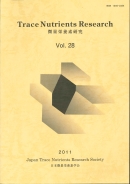28 巻
選択された号の論文の18件中1~18を表示しています
- |<
- <
- 1
- >
- >|
原著
-
2011 年 28 巻 p. 1-9
発行日: 2011/12/22
公開日: 2023/05/26
PDF形式でダウンロード (466K) -
2011 年 28 巻 p. 10-15
発行日: 2011/12/22
公開日: 2023/05/26
PDF形式でダウンロード (132K) -
2011 年 28 巻 p. 16-20
発行日: 2011/12/22
公開日: 2023/05/26
PDF形式でダウンロード (252K) -
2011 年 28 巻 p. 21-26
発行日: 2011/12/22
公開日: 2023/05/26
PDF形式でダウンロード (556K) -
2011 年 28 巻 p. 27-31
発行日: 2011/12/22
公開日: 2023/05/26
PDF形式でダウンロード (294K) -
2011 年 28 巻 p. 32-34
発行日: 2011/12/22
公開日: 2023/05/26
PDF形式でダウンロード (171K) -
2011 年 28 巻 p. 35-39
発行日: 2011/12/22
公開日: 2023/05/26
PDF形式でダウンロード (235K) -
2011 年 28 巻 p. 40-44
発行日: 2011/12/22
公開日: 2023/05/26
PDF形式でダウンロード (637K) -
2011 年 28 巻 p. 45-48
発行日: 2011/12/22
公開日: 2023/05/26
PDF形式でダウンロード (234K) -
2011 年 28 巻 p. 49-53
発行日: 2011/12/22
公開日: 2023/05/26
PDF形式でダウンロード (365K) -
2011 年 28 巻 p. 54-57
発行日: 2011/12/22
公開日: 2023/05/26
PDF形式でダウンロード (172K) -
2011 年 28 巻 p. 58-64
発行日: 2011/12/22
公開日: 2023/05/26
PDF形式でダウンロード (1066K) -
2011 年 28 巻 p. 65-69
発行日: 2011/12/22
公開日: 2023/05/26
PDF形式でダウンロード (351K) -
2011 年 28 巻 p. 70-73
発行日: 2011/12/22
公開日: 2023/05/26
PDF形式でダウンロード (250K) -
2011 年 28 巻 p. 74-78
発行日: 2011/12/22
公開日: 2023/05/26
PDF形式でダウンロード (407K) -
2011 年 28 巻 p. 79-83
発行日: 2011/12/22
公開日: 2023/05/26
PDF形式でダウンロード (262K) -
2011 年 28 巻 p. 84-88
発行日: 2011/12/22
公開日: 2023/05/26
PDF形式でダウンロード (615K)
ミニレビュー
-
2011 年 28 巻 p. 89-94
発行日: 2011/12/22
公開日: 2023/05/26
PDF形式でダウンロード (341K)
- |<
- <
- 1
- >
- >|
